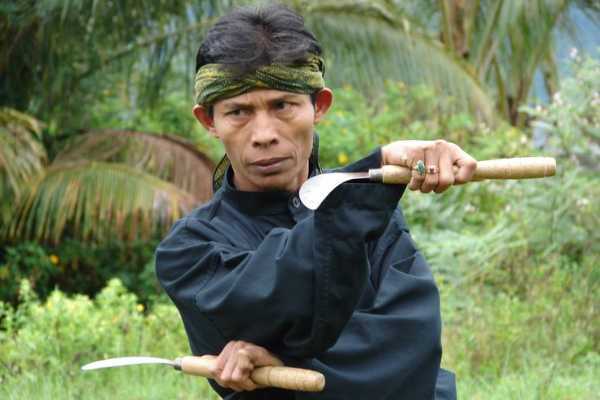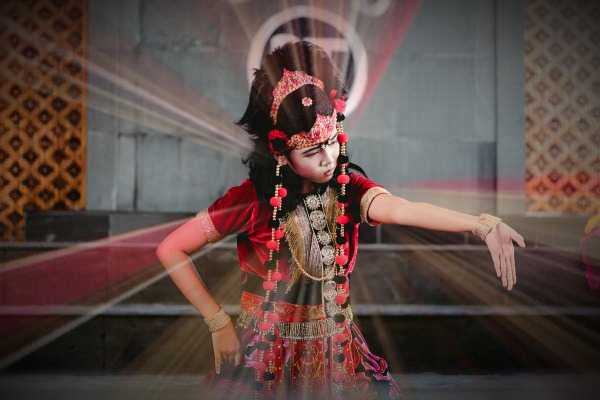The music of the Indonesia Gamelan conceals powerful martial arts applications. The dance of silat is a mnemonic learning system.
Movement combined with music is an efficient method for learning sizeable amounts of intricate knowledge. Drumming, ocular control, and dance are mnemonic learning devices that can control the nervous system. The ability to control the nervous system in combat is an asset. How do you do that? With the art of silat dirty boxing.
Martial Arts Hidden in Plain Sight
How do you practice your fighting skills in a society forbidding such activities? The best way to conceal it is out in the open. Tell your oppressors it’s just a cultural dance form. Then, your oppressors will provide an outlet for the practice of the art.
Many ancient traditions use movement or dance and drumming as communication devices. Some cultures invested considerable time learning how to use movement and sound. Indonesian martial arts systems use these tools as mnemonic learning devices. (1) It makes the silat dance or the dance of silat efficient.
Silat is the ideal method for engaging in the full power of an effective martial art. It combines internalized music, practical applications, and ocular and breath control. It produces a dance-like trance state in which one can practice martial arts hidden in plain sight.
What can you learn by using this strategy? It helps us understand how to use the parasympathetic nervous system to control how we respond to threats.
Dance of Silat Dirty Boxing
The silat dance uses specific ocular techniques to control the Sympathetic Nervous (SN) system. SN is part of the primitive mind that takes control when we encounter potential life-threatening events. (2)
SN activates our “fight, flight, or freeze” response. The SN system injects adrenaline and several other hormones and enzymes that prepare us for danger. It diverts blood flow and adrenaline to our muscles while reducing blood flow to the skin and internal organs. Then, these areas are also shut off to protect the higher thinking centers of the cerebral cortex. It enables quick reactions without thinking using the monkey or reptilian brain.
So, although we can react quickly, we cannot access the higher-functioning aspects of the brain, and that’s the problem. You might be faster with the SN in control; however, it has limited ability to change and adapt to a rapidly changing situation like hand-to-hand combat.
The other characteristic of the primitive mind is that it links to our emotions of fear and anger. In combat, these emotions get in the way of making the best decisions. It requires moving in the right way at the right time. This kind of precision requires the higher-thinking center of the parasympathetic nervous system. It makes the dance of silat effective. It becomes martial arts hidden in plain sight.
Training to Control the Nervous System
Silat dance practitioners train the parasympathetic nervous system to override the sympathetic nervous system’s automatic engagement. With the Parasympathetic nervous system in charge, you can “move on time” and in the “right way.” This is how to defeat a larger, stronger, and faster attacker. Strength and speed are assets of the body, but the mind can beat them.
“Speed is bull____. Timing is everything.” ― Guru Tua
So, how do you train to allow the parasympathetic nervous system to maintain control when we are in a life-threatening situation? You don’t control your fear and anger directly; you use techniques that keep the SN from engaging.
Many refer to this system as silat dirty boxing because it has no rules restricting what can be done. Even martial arts practices like mixed martial arts have rules of engagement, things you can’t do, or places you can’t hit. There are no such rules with the practice of silat.
Keys to the Silat Dance
They say the eyes are the windows to the soul. The eyes are one of the essential keys to controlling the nervous system. If you ever watch a seasoned silat practitioner, one thing you’ll notice is their unblinking stare. It’s not for show; it’s an essential aspect of the system. (3)
Face-to-face confrontations can trigger the emotions of fear and anger, so we must learn techniques that help us maintain emotional equilibrium. We know SN wants to trigger our fight, flight or freeze reaction, so we train to prevent this.
Thus, the biggest battle is always with the Self. You’ll need to learn how to manage these emotions. This is essential in a combat situation and also works in other areas of life.
There are three keys to keeping the Parasympathetic nervous system in control. The first key is to engage ocular control using peripheral vision, the second is to maintain proper body alignment, and the third is to internalize music’s rhythm and melody.
When you use all three tools, you can control the mind and body, enabling you to keep the parasympathetic nervous system engaged. Now you can move in time and the proper way to adjust according to the changing situation.
For the technique to work, you must train to engage peripheral vision and internalize music. Your body follows by adjusting body alignment. All of this takes place in the blink of an eye. Every teacher has their own methods for this essential aspect of the art, and some are more painful than others. We won’t go into the details here. It takes a lot of repetition and hard work.
When these elements are combined, they ensure fluid thinking and movement. Now, you can apply dance as a martial art. It enables you to eliminate powerful emotions like fear and anger, which is a distinct advantage in a combative confrontation. In this sense, a physical fight is not combat but a dance. It also becomes the unfolding of the rhythms of the sacred dance, thus enabling the practice of martial arts hidden in plain sight.
Observing The Practice of the Silat Dance
It doesn’t look like other commercial martial arts with consistent “starts and stops.” It does not follow a constant pace or flow of movement, which is intentional. Many movements are jerky and contain changes in direction. They also include circular, straight-line actions with unusual cadence and tempos.
The one constant of the experienced practitioner is an unblinking stare. You hear them practice their art, slapping their arms, body, and legs using guttural sounds. Many say the movement while executing the Juru. These are all part of the techniques within the dance. They practice and “fight” with their dance.
Combat is not the only goal of the dance. This tradition also incorporates natural healing techniques. Pejut is a healing art and is the predecessor of Reiki and Shiatsu. Pejut contains the energy gained from practicing the dance. It is a healing art like Reiki, but it also has massage elements like Shiatsu.
Learning the Silat Dance
This art comes in many forms. Each region has its flavor—each teacher has a unique background. The body type of students is also a factor. The teacher’s experience is crucial in choosing the right way to train the student.
Many teachers practice more than one flavor of the art and develop their brand. They combine Chinese martial arts concepts. Many teachers of these traditions are very protective of their methods. And for good reasons. You don’t want to teach a bully to be better at bullying.
An excellent teacher will have a vetting process to determine if someone is ready to learn these powerful techniques. A poor student can cause harm to themselves and their teacher. Willem is fond of saying:
“Never teach a monkey to use a hand-grenade. You never know what they will do with it.” ― Guru Tua
These practices are a part of what we call advanced spiritual technologies — advanced because they combine several elements. The goal is to engage the mind and body while minimizing the natural fear response.
Summary
An example of how these elements come together is the Indonesian archipelago. Silat dirty boxing becomes the mnemonic pegboard for martial arts applications. The rhythm and choreographed movement become mnemonic learning devices.
The dance’s cultural aspect enables the practice of martial arts hidden in plain sight. This strategy helped to preserve their art for hundreds of years. Indonesia has been occupied by the Dutch since the 1800s and then by the Japanese during World War II. During these times, people could not keep weapons or practice martial arts. However, they performed their dances for the occupiers.
We include this powerful spiritual technology in our blended learning process curriculum. But, as pointed out above, this is an advanced method. These traditions are a part of the system, which is crucial for conveying cultural heritage.
Silat dirty boxing is a primary vehicle for generating energy to channel into the healing arts, which are a necessary part of the tradition. You will help heal those you train with and vice versa. It requires you to feed your soul and build your spirit. Deal with any emotional or personality issues first. You’ll need a solid base of grounding and centering gained through seated and moving meditation progressions.
References
(1) Using Mnemonic Devices to Make Memorization Easier:
(2) Neuroanatomy, Sympathetic Nervous System:
(3) Physiological Responses During Matches and Profile of Elite Pencak Silat Exponents:



